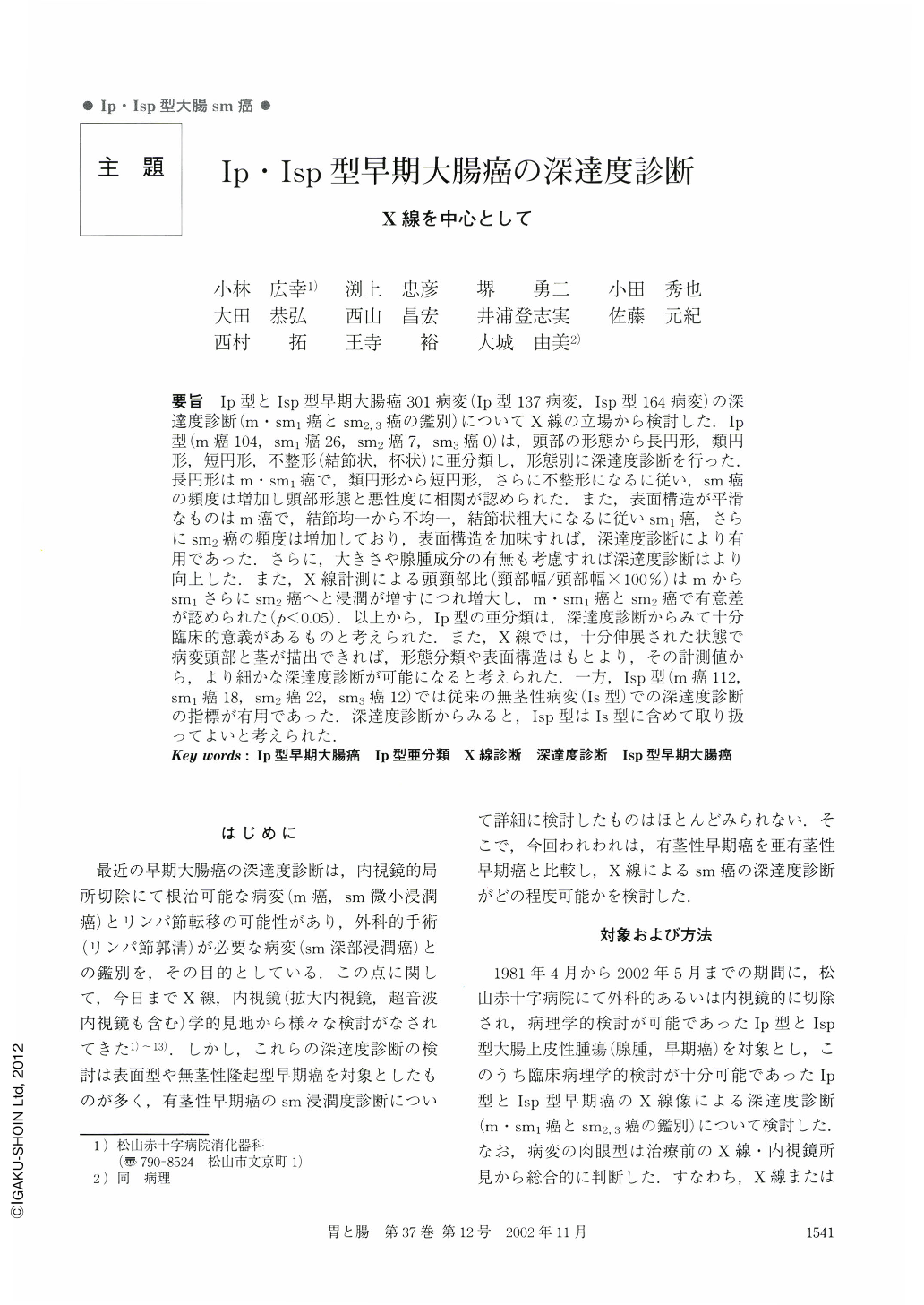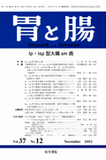Japanese
English
- 有料閲覧
- Abstract 文献概要
- 1ページ目 Look Inside
- サイト内被引用 Cited by
要旨 Ⅰp型とⅠsp型早期大腸癌301病変(Ⅰp型137病変,Ⅰsp型164病変)の深達度診断(m・sm1癌とsm2,3癌の鑑別)についてX線の立場から検討した.Ⅰp型(m癌104,sm1癌26,sm2癌7,sm3癌0)は,頭部の形態から長円形,類円形,短円形,不整形(結節状,杯状)に亜分類し,形態別に深達度診断を行った.長円形はm・sm1癌で,類円形から短円形,さらに不整形になるに従い,sm癌の頻度は増加し頭部形態と悪性度に相関が認められた.また,表面構造が平滑なものはm癌で,結節均一から不均一,結節状粗大になるに従いsm1癌,さらにsm2癌の頻度は増加しており,表面構造を加味すれば,深達度診断により有用であった.さらに,大きさや腺腫成分の有無も考慮すれば深達度診断はより向上した.また,X線計測による頭頸部比(頸部幅/頭部幅×100%)はmからsm1さらにsm2癌へと浸潤が増すにつれ増大し,m・sm1癌とsm2癌で有意差が認められた(p<0.05).以上から,Ⅰp型の亜分類は,深達度診断からみて十分臨床的意義があるものと考えられた.また,X線では,十分伸展された状態で病変頭部と茎が描出できれば,形態分類や表面構造はもとより,その計測値から,より細かな深達度診断が可能になると考えられた.一方,Ⅰsp型(m癌112,sm1癌18,sm2癌22,sm3癌12)では従来の無茎性病変(Ⅰs型)での深達度診断の指標が有用であった.深達度診断からみると,Ⅰsp型はⅠs型に含めて取り扱ってよいと考えられた.
We studied differential diagnosis of the depth of invasion between m, sm1 and sm2,3 in 301 lesions of pedunculated (Ⅰp) and semipedunculated (Ⅰsp) early colorectal cancers from a radiologic viewpoint.
At the beginning, we classified Ip cancers of 137 lesions (m 104, sm1 26, sm2 7, sm3 0) on the basis of the shapes of the heads into the following subtypes ; slender rounded type, rounded type, short rounded type, and unrounded type which was further divided into nodular lesion and arytenoid lesion. The depth of cancer correlated with the subtypes : all of the lesions of slender rounded type were mucosal (m) or slightly invasive (sm1) cancers, and the rate of submucosal cancer was highest in the unrounded type and higher in the short rounded type than in the rounded type. The depth of cancer also correlated with the classification of surface structure : All of the flat surface lesions were mucosal cancers, and the rate of submucosal cancer was highest in the gross nodular surface lesions and higher in irregular nodular surface lesions than in uniform nodular surface lesions. Therefore, it was useful to analyze the factors of the subtypes and their surface structure for differential diagnosis of the depth of invasion. Furthermore, attending to the former factors, it has helped in the diagnosis of the depth of invasion to analyze the size of tumors and the degree of adenoma component in them. The rate of stalk-width/head-width of tumors calculated on radiograms was highest in sm2 cancers, and higher in sm1 cancers than in m cancers. There was significant difference between m, sm1 cancers and sm2 cancers in the rate of stalk-width/headwidth of tumors. From these results, if detailed radiography is performed in which head shape, surface structure and the stalk of pedunculated lesions are demonstrated, it can be said that radiography is extremely useful for diagnosis of the depth of invasion.
On the other hand, according to the result of radiologic evaluation of Ⅰsp cancers in 164 lesions (m 112, sm1 18, sm2 22, sm3 12), radiological diagnosis of the depth of invasion, indicated formerly for sessile colorectal cancers, was also useful for Ⅰsp cancers and it was usually possible to differentiate between m, sm1 and sm2, a cancers. Hence, from the point of view of diagnosis of the depth of invasion, we consider that Isp cancers are better treated in the same way as sessile colorectal cancers.

Copyright © 2002, Igaku-Shoin Ltd. All rights reserved.


